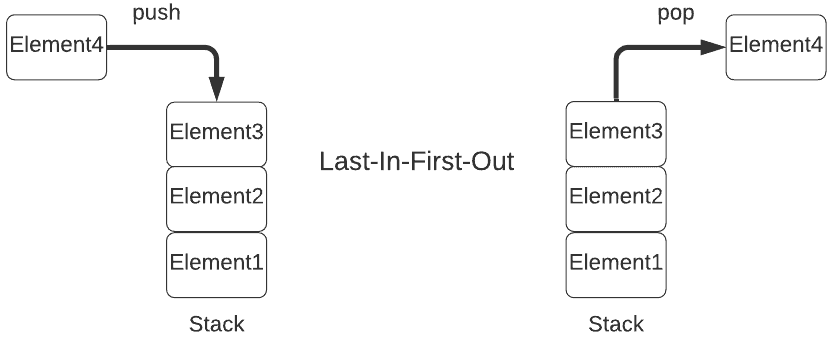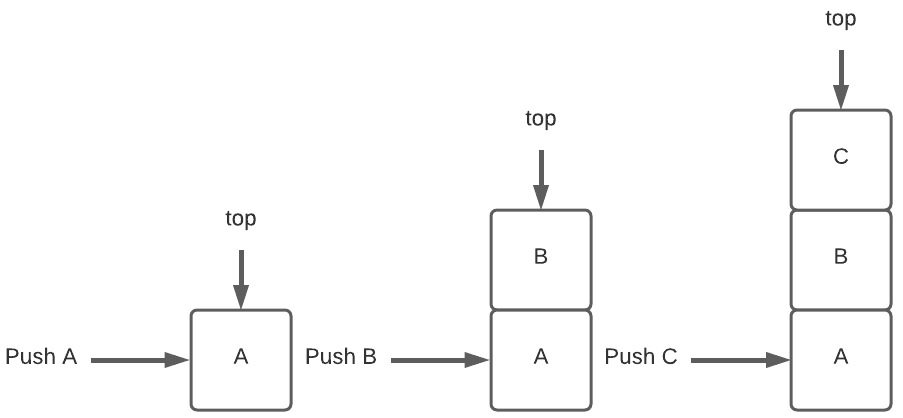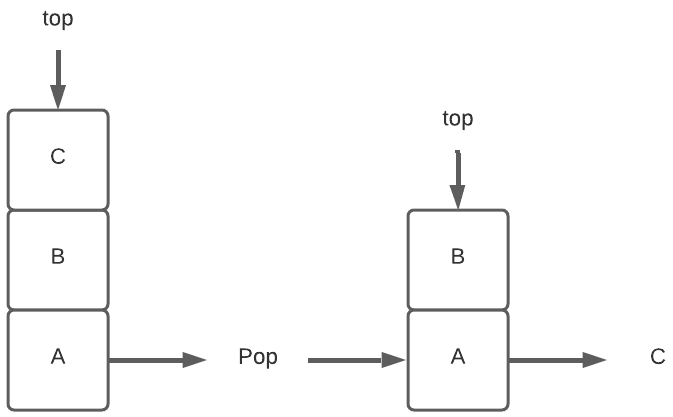1. 简介
在本教程中,我们将学习什么是栈(Stack),以及它是如何工作的。同时,我们也会介绍栈的基本操作及其在编程中的典型应用场景。
栈是一种非常基础且广泛使用的数据结构,在算法、系统调用、表达式求值等多个领域都有重要应用。
2. 什么是栈
栈在生活中随处可见,比如:一摞书、一叠盘子、CD架上的光盘。以书本为例,我们只能从顶部插入或取出书本,这种“只允许在一端操作”的特性,就是栈的核心特征。
✅ 栈是一种只能在一端进行插入和删除的线性表。这一端被称为栈顶(Top)。
栈遵循后进先出(LIFO, Last In First Out)原则。也就是说,最后插入的元素最先被删除,最早插入的元素最后被删除。
因此,栈也被称为先进后出(FILO, First In Last Out)结构。

典型应用场景
- 函数调用栈(Call Stack)
- 表达式求值(如中缀转后缀)
- 括号匹配
- 浏览器的前进/后退功能
- 撤销(Undo)与重做(Redo)功能
3. 栈的表示方式
栈在内存中通常使用数组或链表实现。数组实现更常见,因为栈顶位置固定,便于操作。
下面是一个使用数组实现的栈示意图:

栈顶指针始终指向当前栈顶元素。只能通过栈顶进行插入或删除操作。
4. 栈的基本操作
以下是栈的几个基本操作:
push():将元素压入栈顶pop():弹出栈顶元素peek():查看栈顶元素(不删除)isFull():判断栈是否已满isEmpty():判断栈是否为空
4.1 push() 入栈操作
将元素插入栈顶,栈顶指针上移。
function insertIntoStack(stack, data_element):
// INPUT
// stack = the stack
// data_element = the element to be inserted
// OUTPUT
// Inserts data_element if the stack isn't full; otherwise, returns an overflow condition
if stack is full:
return null
else:
top <- top + 1
stack[top] <- data_element
示例:将 A、B、C 依次压入栈中:

4.2 pop() 出栈操作
将栈顶元素删除,栈顶指针下移。
function removeFromStack(stack):
// INPUT
// stack = the stack
// OUTPUT
// Removes data_element from the top of the stack
if stack is empty:
return null
else:
data_element <- stack[top]
top <- top - 1
return data_element
示例:从包含 A、B、C 的栈中弹出栈顶元素 C:

4.3 peek() 查看栈顶元素
查看栈顶元素但不删除它。
function peekStack(stack):
// INPUT
// stack = the stack
// OUTPUT
// Retrieves data_element from the top of the stack
if stack is empty:
return null
else:
data_element <- stack[top]
return data_element
4.4 isFull() 判断栈是否已满
function isStackFull(stack):
// INPUT
// stack = the stack
// OUTPUT
// Returns true if the stack is full, and false otherwise
if top = MAX_SIZE:
return true
else:
return false
4.5 isEmpty() 判断栈是否为空
function isStackEmpty(stack):
// INPUT
// stack = the stack
// OUTPUT
// Returns true if the stack is empty; otherwise, returns false
if top < 0:
return true
else:
return false
5. 时间复杂度分析
栈的所有操作都发生在栈顶,不需要遍历整个结构,因此时间复杂度均为 **O(1)**。
| 操作 | 时间复杂度 |
|---|---|
| push | O(1) |
| pop | O(1) |
| peek | O(1) |
| isFull | O(1) |
| isEmpty | O(1) |
⚠️ 注意:如果是使用链表实现栈,仍可保持 O(1) 的时间复杂度;但如果使用动态数组实现,push 时可能需要扩容,均摊时间复杂度还是 O(1)。
6. 小结
本文介绍了栈这一基础数据结构的概念、表示方式以及常用操作。总结如下:
- ✅ 栈是一种 LIFO 结构,只能在栈顶进行插入和删除
- ✅ 常见操作包括 push、pop、peek、isFull、isEmpty
- ✅ 所有操作的时间复杂度都是 O(1)
- ✅ 栈在函数调用、表达式求值、浏览器历史记录等场景中非常实用
栈结构虽然简单,但其背后的“后进先出”思想在很多系统设计中都有体现。掌握它,对理解程序运行机制和算法设计都非常有帮助。